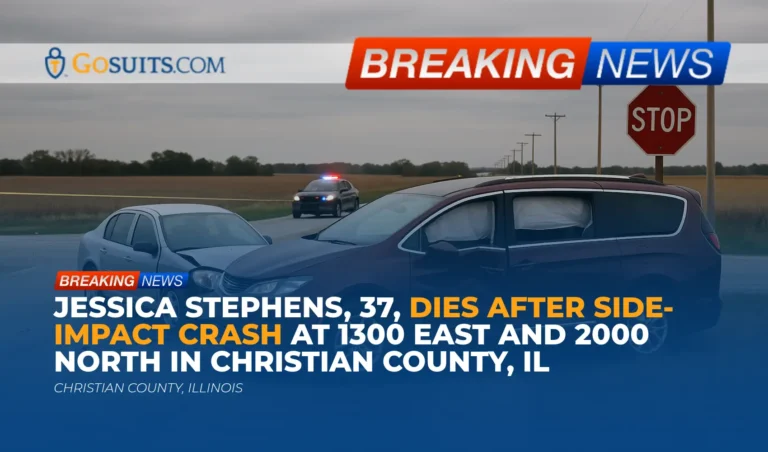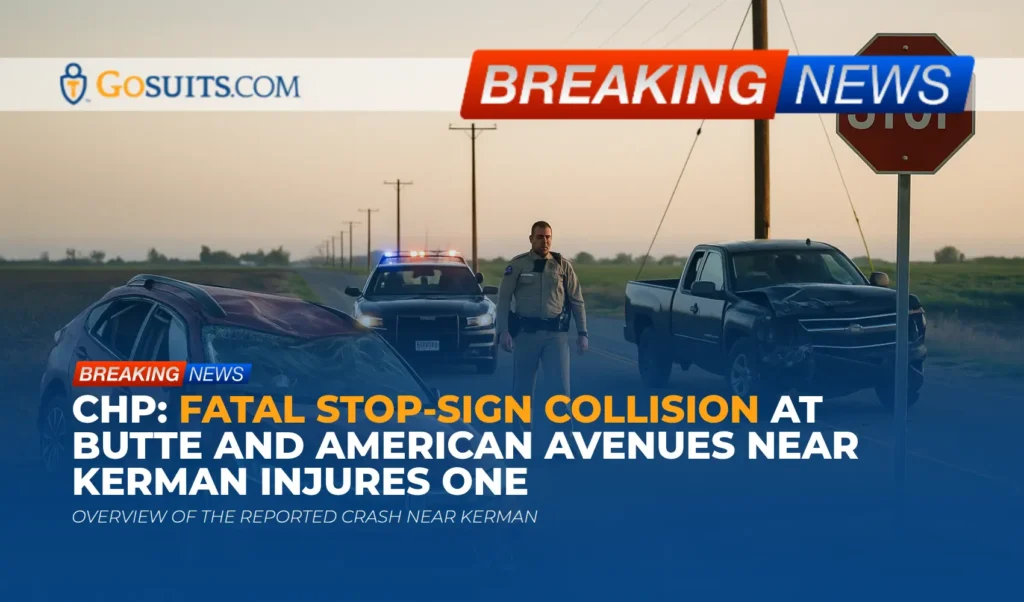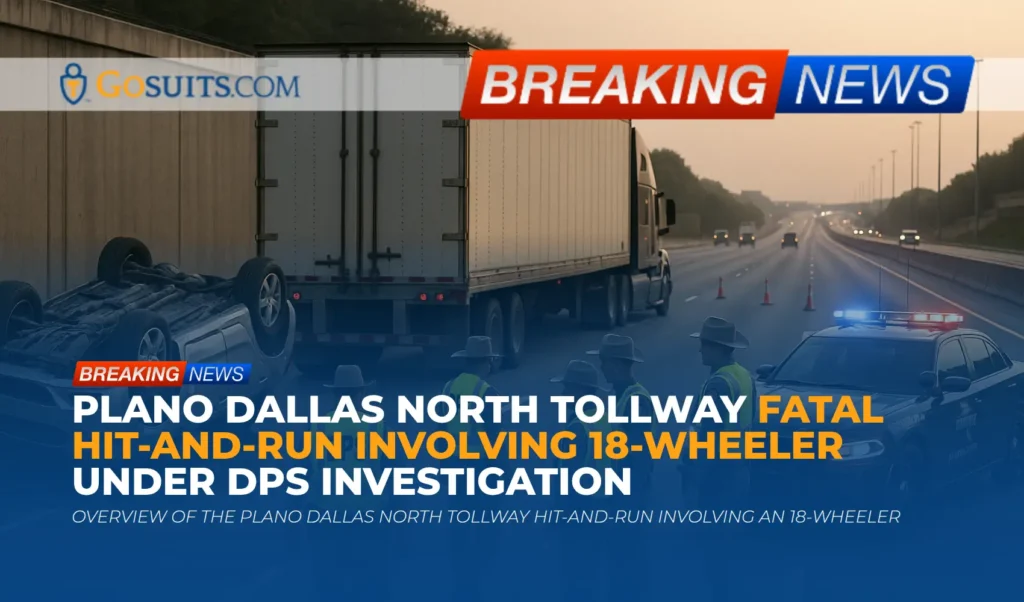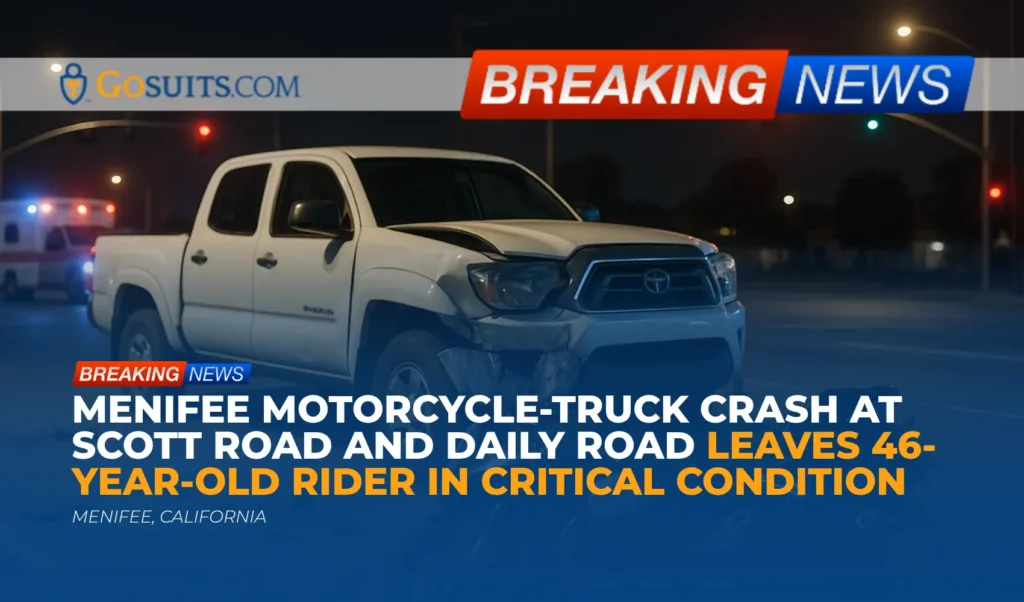- Overview of the Christian County crash at 1300 East Road and 2000 North Road
- What is known from initial reports
- Location, time, and roadway context
- Why side-impact intersection collisions are so dangerous
- Illinois traffic and civil law context in plain language
- How a fatal crash is typically investigated
- Where families can request records and information
- Insurance and financial considerations after a fatal collision
- Practical steps the community can take now
- Why acting promptly matters in Christian County
- References
- Commentary from Gosuits Christian County, Illinois Personal Injury Attorney
Overview of the Christian County crash at 1300 East Road and 2000 North Road
A tragic two-vehicle collision occurred at the rural intersection of 1300 East Road and 2000 North Road in Christian County, Illinois. According to reports, at approximately 7:52 a.m. on October 15, a westbound 2006 Chevrolet Cobalt did not stop and struck a southbound 2019 Chrysler Pacifica on the driver’s side. All occupants were taken to nearby hospitals for emergency care. The driver of the Chrysler Pacifica, identified as 37-year-old Jessica Stephens, died from her injuries.
This article shares verified details available at this time, explains how investigations usually unfold after a fatal crash, outlines general Illinois traffic and civil law principles that often apply, and lists places where families can request official records. It is intended to be compassionate, factual, and supportive to a community processing a sudden loss.
What is known from initial reports
Based on information reported:
- Time and date: Approximately 7:52 a.m. on October 15.
- Location: Intersection of 1300 East Road and 2000 North Road, Christian County, Illinois.
- Vehicles: A westbound 2006 Chevrolet Cobalt and a southbound 2019 Chrysler Pacifica.
- Impact: The Pacifica was struck on the driver’s side.
- Injuries: All occupants were transported to area hospitals.
- Fatality: The driver of the Chrysler Pacifica, Jessica Stephens, succumbed to injuries.
- Reported contributing factor: The westbound Chevrolet Cobalt failed to stop before entering the intersection.
Further details about roadway signage, sight lines, weather, and precise pre-crash movements will usually be clarified in official crash reconstruction documents as they become available.
Location, time, and roadway context
Rural intersections in Illinois, including those in Christian County, often combine lower traffic volumes with higher speeds and variable sight distances. Many are controlled by stop signs rather than traffic signals. Morning traffic can include school, commuting, and agricultural movements, and roadway conditions can vary. Without speculating about this specific crash, these general features can influence crash risk and injury severity on open-country roads.
At an intersection like 1300 East Road and 2000 North Road, questions investigators may explore include:
- Signage and control: Which approaches had stop or yield signs, and were signs visible and in good condition?
- Sight distance: Could drivers reasonably see cross-traffic in time to react?
- Skid or yaw marks: Do road markings show braking or evasive maneuvers?
- Speed and pre-impact paths: What speeds are estimated from vehicle damage, roadway evidence, and any onboard data?
- Lighting and surface condition: Was the roadway dry, and what was the ambient light at the time?
Answers typically appear in the police crash report and, in fatal cases, a reconstruction analysis.
Why side-impact intersection collisions are so dangerous
Side-impact (also called angle or T-bone) collisions at intersections are disproportionately severe because the struck vehicle has less structural space to absorb energy on the side than the front or rear. The Federal Highway Administration notes that a significant portion of fatal and injury crashes occur at or near intersections, and that intersection safety is a national emphasis area because of this risk. See the FHWA’s intersection safety resources for context on frequency and prevention strategies.
- Exposure at intersections: National highway safety agencies highlight intersections as a critical point of conflict between crossing streams of traffic, with elevated risk for angle impacts.
- Side-impact dynamics: When a vehicle is hit broadside, the struck driver’s door area provides less crush space, and injury forces can be severe.
- Seat belts and protection: Seat belts remain the most effective in-vehicle safety feature and significantly reduce the risk of fatal injury in passenger cars. Even so, the geometry of a side collision can lead to major trauma despite restraint use.
While these general points do not assign fault in any specific crash, they explain why a driver-side impact at a rural intersection can result in life-threatening injuries.
Illinois traffic and civil law context in plain language
Stop and yield duties at signed intersections
Illinois law requires drivers to obey stop and yield signs. At a stop sign, a driver must come to a complete stop before entering the intersection and yield the right of way to traffic that constitutes an immediate hazard. For reference, see 625 ILCS 5/11-904. Whether a stop was made and whether it was safe to proceed are fact questions typically addressed by the investigating agency’s report, roadway evidence, witness statements, and any available vehicle data.
Wrongful death and survival claims frameworks
When a fatality occurs, two types of civil claims are commonly discussed in Illinois:
- Wrongful death claim: Brought for the benefit of the decedent’s next of kin to address losses suffered by survivors. See the Illinois Wrongful Death Act at 740 ILCS 180, including time-to-file guidance at 740 ILCS 180/2.
- Survival claim: Brought on behalf of the decedent’s estate for damages the decedent could have claimed had they lived, such as conscious pain and suffering or medical expenses. See 755 ILCS 5/27-6.
Which claims are appropriate depends on the facts, available coverage, and procedural requirements.
Comparative fault in Illinois
Illinois follows a modified comparative fault system. If a claimant is more than 50 percent at fault, recovery is barred; if 50 percent or less, recovery is reduced proportionally by the percentage of fault. See 735 ILCS 5/2-1116. In intersection crashes, insurers and investigators may explore issues such as stopping at signs, speed, lookout, and roadway conditions when evaluating comparative fault.
Time limits to file civil claims
Illinois law imposes deadlines:
- Wrongful death: Generally two years from the date of death, per 740 ILCS 180/2.
- Personal injury: Generally two years from the date of injury, per 735 ILCS 5/13-202.
- Claims against local public entities: May have a shorter one-year period under the Local Governmental and Governmental Employees Tort Immunity Act, see 745 ILCS 10/8-101.
Deadlines can vary based on many factors, so it is important for families to understand time-sensitive requirements in any case involving public roads or agencies.
How a fatal crash is typically investigated
Law enforcement crash reports and reconstruction
After a fatal collision, law enforcement usually secures the scene, documents vehicle positions and damage, measures roadway evidence, interviews witnesses, and may request specialized reconstruction. In Illinois, the Illinois State Police and local sheriff’s offices follow standardized crash reporting practices. IDOT publishes statewide crash reporting resources and forms used by police agencies, which help capture uniform data points in intersection crashes. See IDOT’s overview of Illinois traffic crash reporting at idot.illinois.gov.
Vehicle data and physical evidence
Many vehicles have event data recorders that can store short bursts of pre-crash information such as speed, throttle, braking, and seat belt status. Federal regulations outline standardized data elements for EDRs in certain vehicles; see 49 CFR Part 563. Whether data is available depends on the vehicle model, crash severity, and data preservation. Tire marks, debris fields, and crush profiles also inform speed and angle assessments.
Roadway design and traffic control review
Investigations sometimes include a review of traffic control devices and the roadway environment. Sign placement and visibility are guided by the Manual on Uniform Traffic Control Devices (MUTCD), adopted by transportation agencies to promote uniformity in signs and markings. See FHWA MUTCD. If signage, visibility, or maintenance issues are implicated, separate inquiries or claims procedures may apply and often carry shorter notice deadlines when public entities are involved.
Where families can request records and information
In the days and weeks after a fatal crash, families often need official documents to understand what happened and to handle practical needs. The following sources are commonly involved in Christian County and throughout Illinois. Availability may depend on investigation status and eligibility rules for next of kin.

Police crash report
The primary crash report is prepared by the investigating agency, which could be the Christian County Sheriff’s Office or the Illinois State Police depending on who responded. Copies are typically available after processing. Many Illinois agencies use an online portal or provide reports upon in-person or written request. The Illinois State Police provide guidance for obtaining crash reports at isp.illinois.gov/CrashReports. If a local sheriff’s office investigated, contacting that office directly is usually the correct first step.
Supplemental reconstruction or scene documentation
In fatal cases, there may be supplemental diagrams, measurements, photographs, and reconstruction analyses. These may be part of the police file and could be obtainable when the investigation is complete or via a public records request consistent with the Illinois Freedom of Information Act (see 5 ILCS 140). Some materials can be withheld while an investigation remains open.
Coroner or medical examiner records
In Illinois, county coroners investigate certain deaths, including fatalities from motor vehicle crashes. Families can typically request available documents such as the coroner’s report and, if performed, autopsy and toxicology reports. Eligibility rules vary, and some materials are released only to next of kin or by court order while an investigation is pending. For death certificates, the Illinois Department of Public Health provides instructions for obtaining certified copies; see IDPH Death Records.
Hospital and EMS records
Emergency medical services and hospitals generate records that document care, timing, and observed injuries. Next of kin or the personal representative of the decedent’s estate can usually request these records with appropriate documentation. Hospitals often have a Health Information Management or Medical Records department that provides forms for requesting records.
Other potential sources
- Traffic control and roadway maintenance records: If roadway conditions or signage are at issue, maintenance logs or sign inventories may be available from the responsible highway authority, subject to applicable exemptions and notice requirements.
- 911 audio and CAD logs: Dispatch audio and computer-aided dispatch logs may be requested through the appropriate agency, although these can be restricted while investigations are active.
- Vehicle EDR downloads and ownership documents: Data downloads may occur through law enforcement or by arrangement with qualified forensic technicians if a vehicle is preserved.
Insurance and financial considerations after a fatal collision
Liability insurance for the at-issue driver
Illinois law requires motor vehicle liability insurance. See 625 ILCS 5/7-601. After a crash, the at-issue driver’s insurer typically assigns an adjuster to investigate liability and damages. Statements made to any insurer can carry legal significance. Before giving recorded statements or signing releases, it is generally prudent to consult a qualified attorney to understand rights and obligations.
Uninsured and underinsured motorist (UM/UIM) coverage
Illinois insurance policies usually include UM coverage and, frequently, UIM coverage to protect against drivers who have no insurance or insufficient limits. Illinois law addresses these coverages at 215 ILCS 5/143a-2. UM/UIM claims are made under the decedent’s or a household member’s policy in appropriate circumstances. Policy language and notice requirements matter.
Medical payments coverage and funeral benefits
Many policies offer optional medical payments coverage that can help with medical or funeral expenses regardless of fault, up to the selected limits. Coverage terms, exclusions, and coordination with other benefits (such as health insurance) depend on the policy.
Why to speak with an attorney before any insurer
Insurance companies often contact families quickly. Adjusters may request recorded statements, medical authorizations, or early settlement discussions. What is said can be used later in ways that affect fault assessments or the value of a civil claim. Seeking a free consultation with a seasoned personal injury attorney before communicating with insurers can help protect legal rights, preserve evidence, and ensure that deadlines and coverage options are properly evaluated.
Practical steps the community can take now
Every situation is unique, but the following general actions may help preserve information and support clarity after a serious intersection crash:
- Identify the investigating agency: Determine whether the Christian County Sheriff’s Office or the Illinois State Police handled the scene, and note any incident or report number provided at the time.
- Request the crash report when available: Ask the investigating agency how and when a copy can be obtained. Some reports are available online; others require in-person or mailed requests.
- Track medical care records: Keep a list of hospitals, clinics, and EMS providers involved. Request discharge summaries and billing statements once available.
- Preserve photographs and witness details: Save any photos or videos of the scene and collect names and contact information of witnesses. Maintain a dated log of all communications.
- Secure vehicle preservation: If possible, ensure that vehicles are preserved until necessary inspections and data downloads can occur.
- Avoid early recorded statements to insurers: Before speaking with any insurance company, consider discussing the matter with a personal injury attorney so that rights and obligations are clear. Statements can affect later evaluations.
- Calendar key dates: Mark potential deadlines, especially if any public entity might be implicated in signage, maintenance, or roadway conditions, as those deadlines can be shorter.
- Support and grief resources: Consider notifying employers, schools, and community organizations to coordinate supportive services, leave, or counseling.

Why acting promptly matters in Christian County
Timely action can make a meaningful difference in understanding what happened and in protecting civil rights. Here are focused reasons and the outcomes that can follow:
- Evidence is perishable: Tire marks fade, debris fields are cleared, and vehicles can be repaired or salvaged. Prompt preservation helps ensure that investigators and experts can accurately reconstruct the crash.
- Witness memory fades: People remember best soon after an incident. Early outreach can capture accurate accounts before details are lost.
- Agency processes take time: Coroner reports, crash reconstructions, and medical records often take weeks or months. Initiating requests early helps families obtain critical documents when they are ready.
- Insurance timelines apply: Policies can require timely notice and cooperation. Acting sooner helps ensure coverage is not jeopardized while also allowing thoughtful, informed communications.
- Legal deadlines are strict: Illinois wrongful death and personal injury statutes impose firm time limits, and claims involving public entities may have shorter windows. Early consultation supports compliance with these requirements.
- Financial planning needs: Families may face funeral costs and other urgent expenses. Reviewing available benefits such as medical payments coverage or employer benefits earlier can reduce uncertainty.
The central aim is clarity. Prompt steps safeguard information, reduce misunderstanding, and support careful, compassionate decision-making in the wake of a sudden loss.
References
- 625 ILCS 5/11-904 (Obedience to stop and yield signs)
- 740 ILCS 180 (Illinois Wrongful Death Act) and Section 2 (Limitations)
- 755 ILCS 5/27-6 (Survival of actions)
- 735 ILCS 5/2-1116 (Comparative fault)
- 735 ILCS 5/13-202 (Personal injury statute of limitations)
- 745 ILCS 10/8-101 (Tort Immunity Act limitations for local public entities)
- IDOT: Illinois Traffic Crash Reporting
- Illinois State Police: Crash Reports
- Illinois Department of Public Health: Death Records
- 49 CFR Part 563 (Event Data Recorders)
- FHWA: Manual on Uniform Traffic Control Devices (MUTCD)
- FHWA: Intersection Safety
- NHTSA: Seat Belt Safety
- 625 ILCS 5/7-601 (Mandatory insurance)
- 215 ILCS 5/143a-2 (UM/UIM coverage)
- 5 ILCS 140 (Illinois Freedom of Information Act)
Commentary from Gosuits Christian County, Illinois Personal Injury Attorney
First, heartfelt condolences go to everyone affected by this devastating loss in Christian County. A sudden fatal crash reverberates through families, workplaces, schools, and faith communities. This article is offered for general information and educational purposes to help the community understand the process and issues that may arise after a deadly intersection collision.
Based on the information reported, this appears to have been an angle impact at a rural, stop-controlled intersection, with indications that a westbound vehicle did not stop before entering the cross-traffic lane. In our experience handling serious crashes, these circumstances raise fact questions about stopping, visibility, speed, and right of way that are typically addressed through the police crash report, reconstruction data, and physical evidence. Side impacts to the driver’s side are among the most dangerous collisions on rural roads, which is consistent with the tragic outcome reported here.
It is also important to be mindful of how insurance companies and other involved entities approach these events. Insurers move quickly to collect statements, medical records, and vehicle data. They may engage in early fault assessments or propose quick settlements before the full picture is clear. Without a full understanding of comparative fault rules, available coverages (including UM/UIM), and the documentation needed to support a civil claim, families can find themselves at a disadvantage. Statements given in the first days after a crash can shape liability positions or be cited to minimize contested losses later.
Obtaining a free consultation with a seasoned personal injury attorney before speaking with any insurance adjuster can level the playing field. A consultation helps clarify rights, identify all potential insurance coverages, protect evidence such as event data recorder downloads and scene documentation, and ensure deadlines are understood, especially where a public entity may be involved in roadway signage or maintenance. No two cases are the same, and thoughtful guidance can provide clarity and support at a time when it is needed most.






